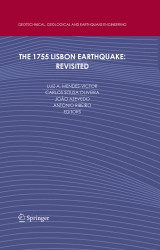Details

The 1755 Lisbon Earthquake: Revisited
Geotechnical, Geological and Earthquake Engineering, Band 7
|
213,99 € |
|
| Verlag: | Springer |
| Format: | |
| Veröffentl.: | 14.10.2008 |
| ISBN/EAN: | 9781402086090 |
| Sprache: | englisch |
| Anzahl Seiten: | 597 |
Dieses eBook enthält ein Wasserzeichen.
Beschreibungen
<P>The 1755 earthquake and tsunami were influential not only in Portugal but in all European and North African countries where the devastating effects were felt. The entire world was deeply impressed and the discussion of its causes generated a large amount of scientific and metaphysical speculation. It inspired philosophers, poets and writers. The socio-economic consequences of the event were great and affected the future organization and development of Portugal. The possibility of a similar occurence urges society and the scientific community to reflect on its lessons.</P>
<P><EM>Audience<BR></EM>This work is of interest to experts in seismology, earthquake engineering, civil protection, urban planning and it is a reference book for doctoral students.</P>
<P><EM>Audience<BR></EM>This work is of interest to experts in seismology, earthquake engineering, civil protection, urban planning and it is a reference book for doctoral students.</P>
Historical Framework.- The Lisbon Earthquake of 1755 in Spanish Contemporary Authors.- The Lisbon Earthquake of November 1st, 1755: An Historical Overview of its Approach.- The Great Earthquakes of Lisbon 1755 and Aceh 2004 Shook the World. Seismologists’ Societal Responsibility.- Seismic Engineering Contributions and Trends to Face Future 1755-Events.- Bruce Alan Bolt 1930–2005 Professor of Seismology, Emeritus.- Social-Economic Impact on Communities Exposed to Earthquakes and Tsunamis.- Catastrophe Risk Management in Developing Countries and the Last Mile.- A Phenomenological Reconstruction of the Mw9 November 1st 1755 Earthquake Source.- The 1755 Lisbon Earthquake and the Genesis of the Risk Management Concept.- Holistic Urban Seismic Risk Evaluation of Megacities: Application and Robustness.- Urban Planning Facing Natural Hazards, Information and Warning.- Risk Estimates for Germany.- Traditional and Innovative Methods for Seismic Vulnerability Assessment at Large Geographical Scales.- Earthquake Early Warning: Real-time Prediction of Ground Motion from the First Seconds of Seismic Recordings.- Simulating Earthquake Scenarios in the European Project LESSLOSS: The Case of Lisbon.- How Distant Earthquakes Contribute to Seismic Hazard in Mainland Portugal.- Propagation and Local Effects on the Seismic Destruction.- Visualization of Seismic Wavefields and Strong Ground Motions Using Data from a Nationwide Strong-Motion Network and Large-Scale Computer Simulation.- Empirical and Theoretical Assessment of Upper Bounds on Earthquake Ground-Motions.- Suboceanic Rayleigh Waves in the 1755 Lisbon Earthquake.- Contribution to the Damage Interpretation During the 1755 Lisbon Earthquake.- How to Build Earthquake Resistant Buildings Under the Environmental Constrains.-Caveats for Nonlinear Response Assessment of Shear Wall Structures.- Rapid Probabilistic Assessment of Structural Systems in Earthquake Regions.- Development of European Shaking Tables.- The Seismic Behavior of Reinforced Concrete Structural Walls: Experiments and Modeling.- Building Performance During Recent Earthquakes in the Iberian Peninsula and Surrounding Regions.- New Approaches to the Seismogenesis on the 1755.- Seismotectonics of the Azores-Tunisia Region.- The 1755 Lisbon Earthquake: A Review and the Proposal for a Tsunami Early Warning System in the Gulf of Cadiz.- Evaluation of the 1755 Earthquake Source Using Tsunami Modeling.- A Finite–Fault Modeling of the 1755 Lisbon Earthquake Sources.- A Statistical Study of the Seismic Intensities of the 1755 Lisbon Earthquake.- Global Response to Large Earthquakes.- Eyewitness Reports of the 2004 Indian Ocean Tsunami from Sri Lanka, Thailand and Indonesia.- Towards a Global Response to Large Disasters.- Post-Tsunami Urban Damage Assessment in Thailand, Using Optical Satellite Imagery and the VIEWSTM Field Reconnaissance System.- Lesson Learnt and Implemented Actions After 2002 Molise-Puglia Earthquake.- The Next 1755 – Myth and Reality; Priorities and Actions to Develop in Case of an Earthquake in the Lisbon Metropolitan Area.
<P>The 1755 earthquake and tsunami were influential not only in Portugal but in all European and North African countries where the devastating effects were felt. The entire world was deeply impressed and the discussion of its causes generated a large amount of scientific and metaphysical speculation. It inspired philosophers, poets and writers. The socio-economic consequences of the event were great and affected the future organization and development of Portugal. The possibility of a similar occurence urges society and the scientific community to reflect on its lessons.</P>
<P><EM>Audience<BR></EM>This work is of interest to experts in seismology, earthquake engineering, civil protection, urban planning and it is a reference book for doctoral students.</P>
<P><EM>Audience<BR></EM>This work is of interest to experts in seismology, earthquake engineering, civil protection, urban planning and it is a reference book for doctoral students.</P>
Comprehensive acknowledgement on the historical context of the large event impact Modern concepts on geodynamics of the Atlantic-Mediterranean seismic prone areas Strategic policies to improve security Existing warning solutions based on terrestrial and space observations Real linkage with emergency management structures and society in general

















